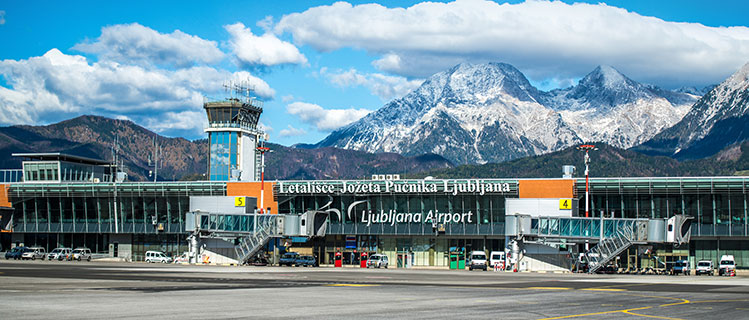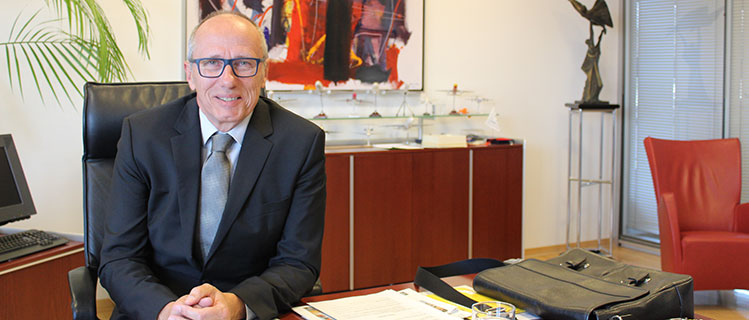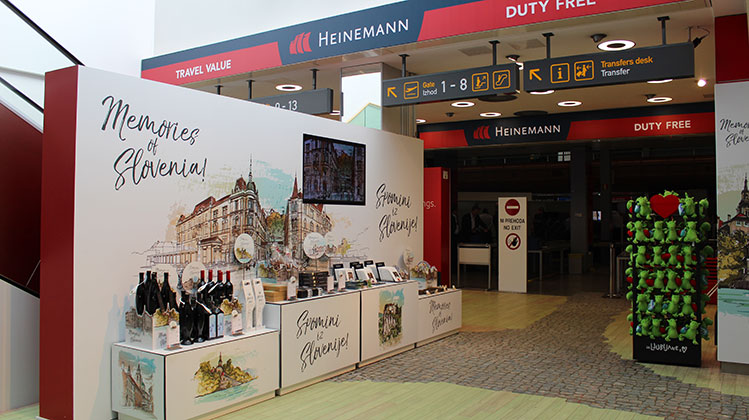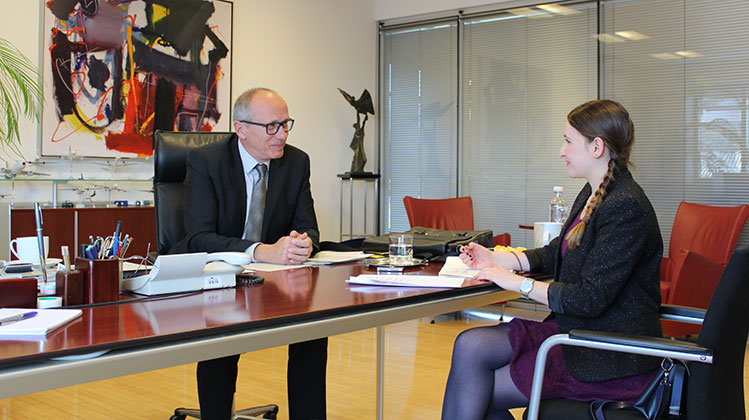Zmago Skobir, Managing Director, Fraport Slovenija, interviewed in Ljubljana by Marta Dimitrova.

Ljubljana is a green oasis in central Europe. The city has become a symbol of how respect for the environment, excellent quality of life and economic growth, can all be successfully combined. The riverbank, running across the town centre is home to numerous cafés, quality restaurants, and great shopping, making it a desirable destination for tourists.
Moreover, Slovenia has a well-developed economy and is, per capita, the second richest of the Slavic countries by GDP behind the Czech Republic.
Benefitting from its strategically-attractive location at the intersection of the traffic flows between the Carpathian Basin and the Po Valley, as well as the corridor from the Middle East through the Bosporus to the European Union, Ljubljana Airport welcomed 1.7 million passengers in 2017, marking positive growth of 19.8%.
“The economy is currently doing well not only in Europe, but worldwide, which means people can afford to travel,” says Zmago Skobir, Managing Director, Fraport Slovenija. “Secondly, knowledge of Slovenia worldwide is getting better and better. And one of the most important factors is that our home-based carrier Adria Airways has restructured successfully and is adding more routes to its network.”
For Skobir, aviation is more than a professional life, it is in fact, his hobby and he has gained a wealth of experience in the aviation and tourism business, holding positions in Adria Airways, Slovenian-based tour operator Globtour, as well as being a Board Member of ACI EUROPE.
“A lot of my experience came from the airline, tourism and infrastructure sectors, which gave me many opportunities to develop and make future-oriented decisions. Because all three businesses are interrelated, I have gained valuable expertise in the field.”
“A more efficient and more recognised airport”
Four years ago, Aerodrom Ljubljana went through a historical transformation when it was acquired by Fraport AG, and then rebranded as Fraport Slovenija. Ljubljana Airport’s attractive proposition as Slovenia’s national air transportation gateway and a vital infrastructure engine for the country’s diversified and growing export-driven economy, as well as an important hub serving the Balkan region, makes it an invaluable asset for the group.
“Fraport AG is one of the biggest airport groups not only in Europe, but worldwide. As a global operator, the brand itself means a lot for the airlines and our partners. For us, the Fraport brand really internationalised us, so we now are on the map worldwide. Secondly, Fraport has extensive knowledge in all fields of operations and ground handling. So, all together this brings us a more efficient and more recognised airport within the Fraport network,” Skobir comments.
The airport recorded a slight decline in passengers in 2016, mainly due to the restructuring of home carrier Adria Airways and other challenges such as increasingly high traffic peaks, however, Skobir explains to Airport Business that Fraport’s knowledge has helped reorganise and restructure the processes within the company, which together helped develop the strategy.
Despite its small population (2 million), which leads to limited network possibilities, Fraport Slovenija has attracted an array of new routes this summer, including flights to Bucharest, Geneva, Hamburg, Sofia, Düsseldorf, Dubrovnik, and Brač. “We are constantly working on the Gulf area, so we are very active in this respect. Not only for Fraport, but also the Slovenian National Tourism Board, it is one of the most important goals for the country and the airport itself. The more direct lines, the more investors, and the more tourists. So, the Gulf is our priority, but we would also like to add more flights from Italy, Spain and Scandinavia to our network.”
He adds: “Germany is also one of the most important countries for Slovenia, as the biggest export partner. That’s the reason why Adria Airways and other carriers will introduce the northern part of Germany, while easyJet introduced flights from Berlin Tegel this summer.”

Zmago Skobir, Managing Director, Fraport Slovenija: “Fraport AG is one of the biggest airport groups not only in Europe, but worldwide. As a global operator, the brand itself means a lot for the airlines and our partners. For us, the Fraport brand really internationalised us, so we now are on the map worldwide.”
New terminal to “future-proof the airport”
Last year, the airport launched a new expansion project, an extension of the existing passenger terminal, in order to avoid a capacity-crunch, caused by a growing number of passengers and a changed traffic structure.
One of the biggest challenges is completing the new terminal extension by the 2020 summer season. “The new terminal will allow us to serve peak traffic periods better, as well as future-proofing the airport for the next 15-20 years, resulting in a better experience for the passengers and the airlines.”
10,000sqm will be added, including a new departure hall with 22 check-in counters, five security lanes, three baggage reclaim carousels, a new baggage sorting area, a large duty free shop, a new business lounge, as well as renovated food & beverage and promotional areas. This will significantly increase capacity from 500 to 1,280 passengers per hour.
Currently, the terminal is in the final stages of design, and this year will see the issue of the public tender. Skobir is positive that construction on the new terminal will start by the end of the year.
Diversifying the non-aeronautical business is a key element of Fraport’s strategy for its airport portfolio. Following the acquisition, Ljubljana Airport adopted a new progressive strategy defined by four pillars – commercial traffic, cargo, real estate, and the development of a new training centre for aviation training.
Education and training of its employees, maintaining high operational standards, and delivering top customer-focused services are among the main priorities of the company.
Zmago Skobir curriculum vitae
Zmago Skobir was appointed Managing Director of Fraport Slovenija in March 2015, after the airport was acquired by Fraport AG. He joined Aerodrom Ljubljana in 2002, first as a Special Advisor to the board. A year later he was appointed a Board Member, and in July 2007 President of the Management Board.
Earlier in his career, after graduating from the faculty of Law at the University of Ljubljana and taking his specialisation at the law faculty in Belgrade, Skobir was Commercial Director at Adria Airways from 1984 to 1998, where he was responsible for launching the domestic airline’s first scheduled services and the establishment of partnership with Lufthansa. During this period, he set up and ran Adria GmbH-Frankfurt, and established the service linking Ljubljana with Frankfurt. The next step in his career was at the helm of Globtour. He was the driving force behind the establishment of the SPOT (Slovenian Power of Tourism) consortium, and was also a member of the tourism commission at the Ministry of the Economy and a member of the expert council at the Slovenian National Tourism Board.
In 2016, Fraport Aviation Academy was established at Ljubljana Airport, underscoring Fraport Slovenija’s commitment to enhancing Ljubljana as a sustainable location. The academy will initially provide training in the fields of airport management, ground handling and rescue management. Additionally, a new firefighting training centre is being built.
“A lot of institutions around us are offering theoretical knowledge. We are focusing on the practical knowledge, which is missing elsewhere. The location we thought is also quite appropriate geographically. Those are the main factors where we see this should be a success, and also a little bit different than other competitors. Apart from Fraport AG, we are also partnering with Adria Airways and Slovenian Air Traffic Control, and we are hoping for a good development of this project,” Skobir enthuses.
“A future potential hub and consolidating centre”
Due to its strategic geographical position on the crossroad from Central Europe to the Balkans, Slovenia is destined to be a logistic hub. This is clearly translated in the development of the new Airport City, which will develop the airport’s commercial infrastructure in order to meet the needs for logistic services, hotel accommodation, office space and commercial premises.
“Our airport is also becoming an increasingly important logistics hub. Novartis, one of the biggest pharmaceutical producers, is finalising its European warehouse here. Cargo-partner has started building a big warehouse near the airport. Other international companies are also recognising this area as a future potential hub and consolidating centre.”
Another aspect of the newly-adopted strategy is the commercial and retail development. “The retail business is quite an important part of our activities here at the airport, revenue-wise,” says Skobir. “We have different passengers. We have to find ways to attract passengers to spend more time at the airports. Together with our partners, we have outsourced the food & beverage offering. We strive to change our offer quite often. In retail, more and more local products are desired by passengers.”
Carbon neutral by 2020
As capital of one of Europe’s most forested countries, it is fitting that Ljubljana was named European Green Capital in 2016 by the European Commission, recognising the city’s high environmental standards as part of its sustainability strategy ‘Vision 2025’.

Ljubljana Airport strives to respond to current consumer trends by offering more and more local products, as well as changing the offer more frequently.
Ljubljana Airport is currently accredited at Level 2 Reduction of ACI’s Airport Carbon Accreditation, and has reduced its carbon footprint by 40% since 2012. “This means that from 3.6 kilos of carbon dioxide per passenger in 2012, we dropped down to two kilos per passengers in 2017,” says Skobir. “We have established a carbon management plan, implemented LED lighting where possible, and are introducing more energy-efficient ways of heating the terminal.”
The airport has also implemented a new mobility system, which includes electric car-sharing and bikes around the city. The electric car sharing is available for passengers, as well as employees. Travellers can make a booking via their smartphone and then use the code to unlock the car.

Talking to Airport Business, Fraport Slovenija’s Managing Director Zmago Skobir stresses: “We have benefitted from Fraport’s operational and management knowledge to reorganise our activities in 2017 and to build for growth opportunities in the future.”
The next step will be to introduce electric ground-handling equipment. “We are starting with some of the forklifts and tractors. Then we will introduce e-vehicles every year into our plan, thus further reducing our carbon footprint and helping Ljubljana and Slovenia to be even greener – not only as a country, but as Slovenia’s gateway to the world.”
“Creating a feel of Slovenia”
Arriving at the airport, passengers are instantly captivated by the picturesque landscape of the Alps surrounding the city. Ljubljana Airport works closely with the Slovenian National Tourism Board in Slovenia to implement digital advertising in the arrivals hall dedicated to promoting this view.
“For example, when Turkish Airlines was increasing its frequencies, it put in a lot of effort with our Slovenian National Tourism Board to bring the tour operators from Korea, Japan, and China to introduce them to Slovenia,” Skobir explains. “Even though Slovenia is a small country, it is the best place for travellers from Asia to start their journey and continue to our neighbouring countries.”
A key focus is the friendly customer experience provided by the airport’s staff. “Professionalism, kindness and good information are the main tasks for our staff to create the feel of Slovenia.”
It is also hard not to notice the rich art collection that can be seen in the terminal, as well as at Fraport Slovenija’s headquarters. The company boasts an art collection of renowned painters, which presents a significant overview of Slovenia’s modern art.
After a record year in 2017, and the opening of a new road link, in line with the four-pillar strategy, the company is ready for further growth in 2018. It plans to further develop its commercial activities within the airport complex, while at the same time ensuring enhanced passenger and customer satisfaction by investing in the new passenger terminal and developing cargo transport.







